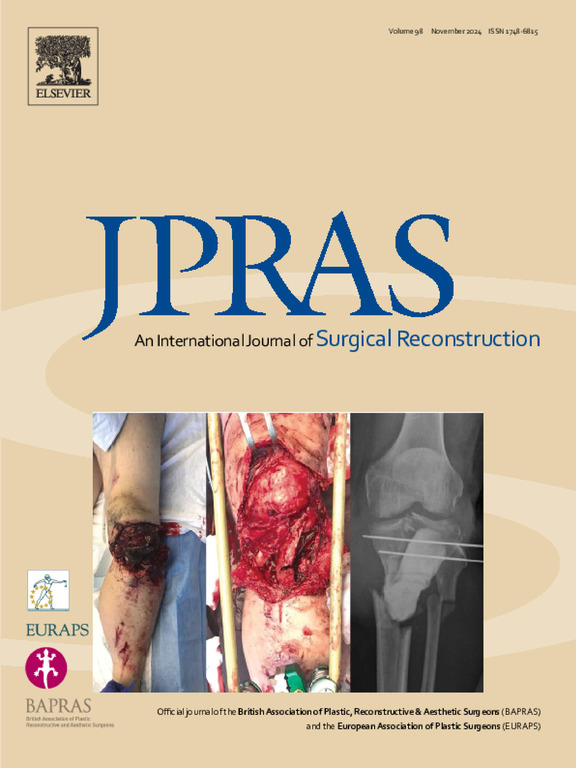腹壁穿孔修补术的临床应用
IF 2.4
3区 医学
Q2 SURGERY
Journal of Plastic Reconstructive and Aesthetic Surgery
Pub Date : 2025-04-17
DOI:10.1016/j.bjps.2025.04.024
引用次数: 0
摘要
背景与目的在腹下深动脉穿支(DIEP)皮瓣重建的手术规划中,穿支的选择至关重要。本研究旨在评估腹下深动脉(DIEA)穿支的解剖学变化及其在穿支体内的主要皮下分支模式,并利用三维计算机断层血管成像(CTA)建立一个新的命名系统。方法对180例行DIEP皮瓣重建术前显像的患者进行腹部CTA扫描。最大强度投影(MIP)和体绘制技术(VRT)重建用于映射穿支解剖结构。分支模式与穿支的位置和皮下路线有关,在前直肌鞘中出现。结果将成形器划分为3大类,并根据支静脉的走向进一步细分。I型射孔器最为常见(87.2%),为单干式射孔器(IA)或内角≤30°的分叉式射孔器(IB)。II型射孔器(7.5%)在180±20°(IIA)或30°至160°(IIB)之间分叉。III型穿孔器(5.3%)产生3个或更多的主分支。平均每半腹部有2.9±1.6个穿支。在靠近脐部的地方发现较大口径的血管(P <;0.005)。大多数穿支(80.5%)从脐尾直肌鞘穿出,沿内外侧方向走行。结论本研究提供了一种新的DIEA穿支的主要皮下穿支体分支类型分类,并强调了改善皮瓣设计和手术结果的临床意义。本文章由计算机程序翻译,如有差异,请以英文原文为准。
Refining the abdominal wall perforasome with clinical application
Background and purpose
Perforator selection is critical during operative planning for deep inferior epigastric artery perforator (DIEP) flap reconstruction. This study aimed to evaluate the anatomical variations in deep inferior epigastric artery (DIEA) perforators and their primary subcutaneous branching patterns within the perforasome, using three-dimensional computed tomography angiography (CTA) to develop a new nomenclature system.
Methods
Abdominal CTA scans of 180 patients undergoing preoperative imaging for DIEP flap reconstruction were evaluated. Maximum intensity projection (MIP) and volume-rendering technique (VRT) reconstructions were used to map perforator anatomy. Branching patterns were correlated to the location and subcutaneous course of the perforators, at emergence from the anterior rectus sheath.
Results
Perforators were classified into 3 main categories and further sub-classified based on the orientation of tributaries. Type I perforators were the most common (87.2%) and coursed as a single trunk (IA) or bifurcated with an internal angle ≤30° (IB). Type II perforators (7.5%) bifurcated at 180 ± 20° (IIA) or between 30° and 160° (IIB). Type III perforators (5.3%) produced 3 or more primary branches. On an average, there were 2.9 ± 1.6 perforators per hemi-abdomen. Larger caliber vessels were found closer to the umbilicus (P < 0.005). Most perforators (80.5%) exited the rectus sheath caudal to the umbilicus and coursed in an inferolateral direction.
Conclusions
This study provides a novel classification of the primary subcutaneous perforasome branching patterns of DIEA perforators and highlights the clinical implications for improved flap design and operative outcomes.
求助全文
通过发布文献求助,成功后即可免费获取论文全文。
去求助
来源期刊
CiteScore
3.10
自引率
11.10%
发文量
578
审稿时长
3.5 months
期刊介绍:
JPRAS An International Journal of Surgical Reconstruction is one of the world''s leading international journals, covering all the reconstructive and aesthetic aspects of plastic surgery.
The journal presents the latest surgical procedures with audit and outcome studies of new and established techniques in plastic surgery including: cleft lip and palate and other heads and neck surgery, hand surgery, lower limb trauma, burns, skin cancer, breast surgery and aesthetic surgery.

 求助内容:
求助内容: 应助结果提醒方式:
应助结果提醒方式:


